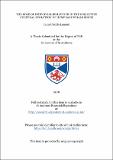Files in this item
The role of individual behaviour in the collective cultural evolution of humpback whale songs
Item metadata
| dc.contributor.advisor | Rendell, Luke | |
| dc.contributor.author | Lamoni, Luca Ubaldo | |
| dc.coverage.spatial | viii,198 p. | en_US |
| dc.date.accessioned | 2019-10-07T08:39:21Z | |
| dc.date.available | 2019-10-07T08:39:21Z | |
| dc.date.issued | 2018-12-06 | |
| dc.identifier.uri | https://hdl.handle.net/10023/18621 | |
| dc.description.abstract | For more than forty years, the complex songs emitted by humpback whales have fascinated the scientific community as well as the general public. These songs are produced by males during the breeding season, and are hierarchically structured and population specific. Within a population, males tend to conform to the same song type, but songs undergo gradual unidirectional change. Instances of more rapid song changes have also been recorded, where the song sung by a population has been replaced by the song of an adjacent population. The learning mechanisms that concurrently drive song conformity, and simultaneously allow gradual (evolution) and rapid (revolution) song change are not currently understood. This thesis aims to address this gap by using innovative theoretical models as well as more established empirical methods. Chapter 1 provides a general introduction to the thesis topics. In chapter 2 I introduce a spatially explicit agent-based modelling approach to investigate humpback whale song evolution and transmission. I found that shared feeding grounds promote inter-population song transmission, song conformity emerges as a function of breeding ground geographical segregation, and production errors facilitate gradual evolution of songs. In chapter 3, the same modelling approach is extended to simulate song revolutions using a new learning bias in combination with different movement scenarios. I found that the consistent emergence of song revolutions is dependent on cognitive (song memory), behavioural (singing probability) and spatial (agent density) factors. Finally, in chapter 4, I analyse intra- and inter- individual song variability at different hierarchical levels of organisation in songs recorded off eastern Australia. I found that variability is not homogeneously distributed across the different song levels. Furthermore, I identified consistent and distinctive individual patterns of song production consistent with the theory that songs could represent mate quality advertisements for females. | en_US |
| dc.description.sponsorship | "This work was supported by Leverhulme Trust Grant [grant number: RPG-2013-367]" -- Acknowledgements | en |
| dc.language.iso | en | en_US |
| dc.publisher | University of St Andrews | en |
| dc.title | The role of individual behaviour in the collective cultural evolution of humpback whale songs | en_US |
| dc.type | Thesis | en_US |
| dc.contributor.sponsor | Leverhulme Trust | en_US |
| dc.type.qualificationlevel | Doctoral | en_US |
| dc.type.qualificationname | PhD Doctor of Philosophy | en_US |
| dc.publisher.institution | The University of St Andrews | en_US |
This item appears in the following Collection(s)
Items in the St Andrews Research Repository are protected by copyright, with all rights reserved, unless otherwise indicated.

